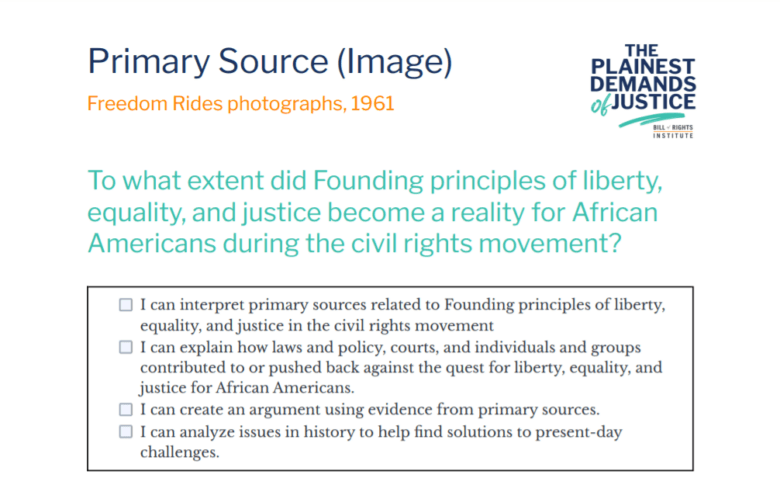Freedom Rides Photographs, 1961
To what extent did Founding principles of liberty, equality, and justice become a reality for African Americans during the civil rights movement?
- I can interpret primary sources related to Founding principles of liberty, equality, and justice in the civil rights movement
- I can explain how laws and policy, courts, and individuals and groups contributed to or pushed back against the quest for liberty, equality, and justice for African Americans.
- I can create an argument using evidence from primary sources.
- I can analyze issues in history to help find solutions to present-day challenges.
Building Context
In Morgan v. Commonwealth of Virginia (1946), the Supreme Court had ruled that segregated seating on interstate buses was unconstitutional, but the ruling was largely ignored in southern states. In 1960, the Supreme Court followed up on its earlier decision and ordered the integration of interstate buses and terminals. In 1961, the Congress of Racial Equality (CORE), which had been formed in 1942, came up with the idea for a “freedom ride” to desegregate interstate buses. The Freedom ride consisted of an interracial group riding the buses from Washington, DC, to New Orleans to commemorate the anniversary of the Brown v. Board of Education decision. CORE sent letters to President Kennedy, his brother Attorney General Robert Kennedy, Federal Bureau of Investigation (FBI) director J. Edgar Hoover, the chair of the Interstate Commerce Commission, and the president of the Greyhound Corporation announcing their intentions to make the ride and hoping for protection. CORE decided to move forward despite receiving no response. The 13 “Freedom Riders” underwent three days of intensive training in the philosophy of nonviolence, role playing the difficult situations they could expect to encounter. Their journey began on May 4, 1961. The riders were met with varying degrees of resistance and outright violence as they traveled south.
Freedom Rides photographs, 1961
Source: https://www.fbi.gov/history/brief-history/and-justice-for-all
A Greyhound bus carrying Freedom Riders was firebombed by an angry mob while in Anniston, Alabama, in 1961. Forced to evacuate, the passengers were then assaulted. (Credit: “Freedom Riders Bus Attack” by Federal Bureau of Investigation)
Source: https://www.floridamemory.com/items/show/267348
Freedom Riders Priscilla Stephens from CORE and Reverend Petty D. McKinney are shown after their arrest by the police in Tallahassee, Florida, in June 1961.
Comprehension and Analysis Questions
- Based on the photographs provided, what happened to the Freedom Riders?
- How did the nonviolent tactics of the Freedom Riders put them in more danger? Why do you think they chose this tactic?
- Across the country, the public learned about the violence as images of burning buses and beaten Freedom Riders were broadcast on television and printed in newspapers. How might this news coverage have affected the civil rights movement?


